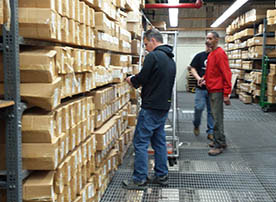There are many factors to consider when deciding whether to store records offsite in commercial storage or to set up your own inactive records storage area:
- Cost: supplies, equipment, and related services (retrieval, destruction, and transportation)
- Physical structure: soundness of structure, fire suppression system, mechanical systems, and loading dock
- Security: locks on doors, limited access, alarm system, and random ordering of boxes to prevent unauthorized access
- Space requirements: current volume of records plus future growth
- Environmental conditions: temperature and humidity controls, regular cleaning, and light and window coverings
- Safety: adherence to building/fire codes and prevention of water damage to records
- Operation: staffing plan and assignment of responsibilities
Storing Records Offsite in Commercial Storage Space
Local governments and state agencies do not have to store their records in their own facilities. They can store their records in commercial records storage facilities, and state agencies can also store their records at the New York State Archives' State Records Center on the State Office Campus in Albany. Local governments must seek approval from the Archives prior to storing records in facilities other than those owned or maintained by the local government and should contact their Records Advisory Officer. For specific information on data storage, including storing records in the cloud, see Using a Data Storage Vendor.
Setting Up an Inactive Records Storage Area
You should carefully plan before setting up a storage area for inactive paper records. You must consider how to manage the facility including security, fire suppression, shelving arrangement, a location and retrieval system for the records, among other things. For more information on developing and maintaining a records center, consult the Guidelines for Storage of Inactive Government Records.

